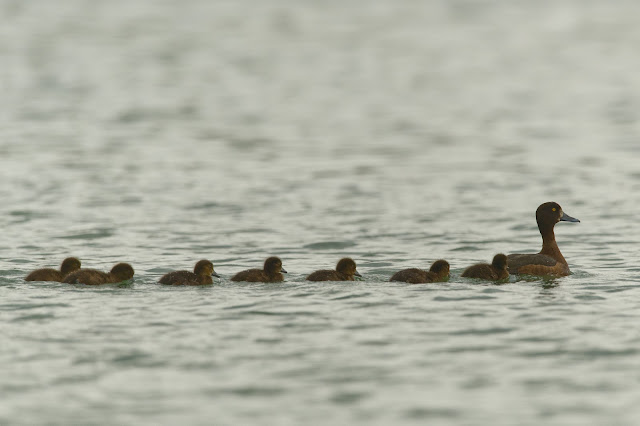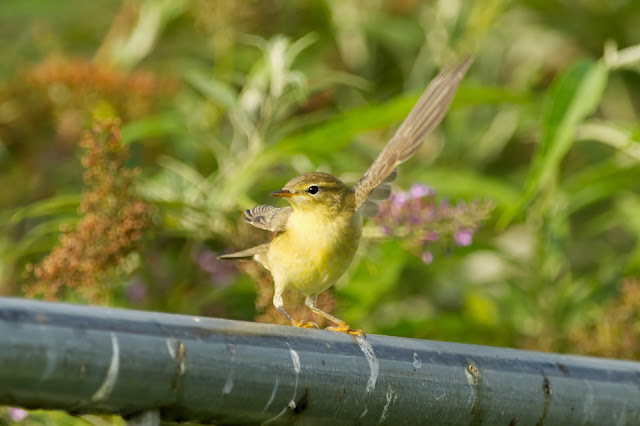 July was marked by an exceptional passage of Black-tailed Godwits pic @Chris_Farthing
July was marked by an exceptional passage of Black-tailed Godwits pic @Chris_Farthing
A flying visit by the reservoirs' third ever Glossy Ibis, an even briefer appearance by two Turnstone and the first, if ultimately unsuccessful, breeding of Barnacle Geese were the highlights of June and July. The summer also saw the most glaring gaps in the year list closed with Redshank and Garden Warbler both seen along with the now expected appearance of Yellow-legged Gull and annual visit by the strangely elusive Coal Tit.
Summer saw the Wetlands alive with breeding birds including regionally important numbers of Pochard as well as a juvenile Cuckoo on site for the second year running. The six additions to the year list bring the total to 123, nine behind last year but the same total as in 2020.
Two pairs of Barnacle Geese bred but sadly no young survived pic @IvorHewstone After a near miss last year, two pairs of Barnacle Geese hatched young for the first time. Five cute goslings delighted visitors as they fed happily with their parents along the public No 4/5 path. Sadly there was no happy ending with all the young and, indeed, an adult disappearing one-by-one over time with gulls and foxes the culprits. It looks, however, that Barnacle Geese may become a summer feature of the reservoirs as No 5 played host to a moulting flock of 20 in July and into August.
The Wetlands played host to 20 Barnacle Geese who stayed into August pic @Chris_Farthing
It was equally dismal breeding story for
Shelduck. Two pairs had ducklings but, just like last year, none survived long. This failure again prompted an early departure of the adult birds with the last two seen on June 26th. It was better news for
Pochard with 15 pairs raising 20 young between them. Most females were lucky to keep one duckling safe from the marauding gulls so a special shout-out to the two mothers on High Maynard who co-parented a presumed combined brood of ten from the earliest stage and raised them all to maturity.
New families of Tufted Ducks are still appearing but, but by the beginning of August, a record 46 broods have been counted. This compares to an estimated 30 last year which itself was a big rise on the 18 in 2020. While there were plenty of broods, the attrition rate among the young is high. Gadwall seem to do better with at least two pairs raising young successfully.
 Record numbers of Tufted Ducks have bred at the Wetlands this year pic @giles_greenwood
Record numbers of Tufted Ducks have bred at the Wetlands this year pic @giles_greenwood
Even as female Tufted Ducks were bringing their tiny ducklings onto the water for the first time, the largely male moulting flocks were gathering as usual. A count of 1908 Tufted Ducks was made in mid-July across the site which again will be among the biggest flocks in London. Among the moulting duck were 177 Pochard. Single Shoveler were recorded on several days in June, with higher counts in July, while the first returning Teal was seen on June 16th.
June got off to a great start when on the 1st CF saw a distant Glossy Ibis disappearing south over Lockwood. It was re-found circling low twice over East Warwick before continuing on its way after its 15 minute flying visit. It is the third record for the reservoirs following singles in October 2015 and September 2017. Among the Little Egrets feeding at the Wetlands in July was a bird which had been colour-ringed in the nest 20 km north in 2013 and had not been reported anywhere in the intervening nine years.
Single Red Kites were seen on June 9th, July 5th and July 15th with the sole Buzzard record on June 10th. Hobby were slightly more regular with four records in June and two in July. Peregrines, usually a near-resident at the Wetlands, were much scarcer this year with only occasional visits from the pairs nesting in Tottenham and Walthamstow town. A Water Rail calling in the No 1 reed bed on June 18th was a good sign of breeding.
Ten species of wader were seen over June and July, one fewer than last year with Oystercatcher the surprising omission. There seemed to be only a week gap between what were presumably the last summer-plumaged Dunlin heading north in early June and the re-appearance of Green Sandpipers. - perhaps failed breeders - in June with the first on the 13th and records from four other dates in the month.
 Dunlin are invariably tame when they stop at the Wetlands on their migration pic @ AMP
Dunlin are invariably tame when they stop at the Wetlands on their migration pic @ AMP
For the second consecutive year, Avocet was seen in June with one on the June 21st, 11 days later than last year's record. Five Lapwing were seen on June 23rd, two on July 14th and one on July 27th and next day. Adult Little Ringed Plover were recorded on two dates in June and on July 4th with a tame juvenile on East Warwick on July 27 & 28th.
A remarkable number of Black-tailed Godwits were seen in July this year pic @porthkillier July is usually a good month for Black-tailed Godwits at the reservoirs but this year's passage was exceptional. A flock of 11 on July 3rd over East Warwick was followed by 30-plus over the same reservoir on the 13th. Surprisingly tame birds then appeared on Lockwood on July 21st and 28th with two on the 27th. The best wader of the period were two Turnstone found by T &PR on Lockwood on July 25th. They are not even annual visitors with no records at all in 2018 or 2019 so they might have had the decency to stay longer than five minutes before carrying on their way.
 Redshank finally made the year list with two belated records in July pic @Chris_Farthing
Redshank finally made the year list with two belated records in July pic @Chris_Farthing
Two smart summer-plumaged Dunlin were seen on June 6th with returning singles on July 25th and 28th. The first Common Sandpiper of the 'autumn' was seen on June 25th - five days earlier than last year's first returnee but two days later than in 2020. Green Sandpipers are usually the earliest returning wader with the first this year on June 13th with records from four other dates in the month. The embarrassing gap of Common Redshank in the year list was finally closed when CF found one on July 21st followed, typically, by two next day.
Black-headed Gulls successfully moved their colony to Lockwood this year pic @AMP
The noisy Black-headed Gull colony, forced to move to Lockwood when their East Warwick raft was blown ashore, don't seem to have minded the change of scene with perhaps 100 young raised. Their move may have impacted slightly on the Wetland's Common Terns which bred on the raft last year with what seems like a slight fall on last year's 17 pairs. Fortunately, ten pairs were attracted by PS's decoys onto the rafts on West Warwick with at least two more pairs squeezing in among the Black-heads on Lockwood. It is hard to know how many young they raised but six were rung on West Warwick and as many un-rung birds were seen resting on Lockwood.
 Lockwood became a nursery for Common Terns pic @rudraksh9
Lockwood became a nursery for Common Terns pic @rudraksh9 July is a good month to find a Yellow-legged Gull at the Wetlands as it sees the juveniles arrive in the UK. SJ found the first on the 28th, three days later than the first record last year with RE finding a second later that afternoon . The 28th was also the date the first returning Common Gulls were noted.
One of two juvenile Yellow-legged Gulls seen on Lockwood pic @wheresrhys
Hundreds of Swifts continued to use the Wetlands and adjoining filter beds to feed but numbers dropped towards the end of July as local birds finished breeding and moved south. They should be replaced later in August by birds which have bred further north who use the reservoirs as a fueling station. In contrast, Sand Martin numbers increased towards the end of July when up to 70 - often joined by House Martins from the filter bed colony - fed low East Warwick early morning. The only Swallows recorded were singles on June 11th and July 21st.
Migrant Sand Martins joined local breeders at the reservoirs in July pic @rudraksha9
The good summer for Cuckoos continued with one on June 16th and, as last year, a juvenile in July on the 8th. Kingfishers also had a productive year with two pairs breeding either or just off site. They are being seen regularly along the Coppermill Stream opposite the Ferry Boat Inn and at the south end of No 3 reservoir. For some reason, June seems to be the best month to catch up with Coal Tit, an inexplicable Wetlands rarity with PH hearing one early morning on 7th by the No 1 reservoir ringing site - 16 days earlier than last year's only record.
For the second year running, a young Cuckoo appeared in July pic @Chris_Farthing
Summer also saw out-of-season appearances by failed breeders or wandering juveniles. Skylarks were seen on June 4th, July 7th and July 15th. As last year, a female Wheatear turned up in June on the 10th with a Yellow Wagtail on June 3rd.
Ringing suggests that Reed Warbler numbers are well down on last year with both fewer breeding pairs and a worrying large fall in the number of juveniles caught. Bad weather as the birds moved north and the extraordinary heat and drought affecting food are perhaps reasons for this decline. Reasonable numbers, however, of young Blackcap, Chiffchaff and Common Whitethroats seem to be around although ringing data will again show if these species, too, have been hit by the weather. Lesser Whitethroats do look, however, like one species which has done pretty well with family parties seen in several areas of the Wetlands.
Both Common (below) pic @giles_greenwood and Lesser Whitethroats pic @rudraksha9 bred
Unusually no Garden Warblers were heard or seen in the Spring with the first bird picked out by LB among a cacophony of bird song near the East Warwick hide on June 18th. It moved on within the hour but two more were caught on July 16th and 23rd during the ringing sessions. The first returning Willow Warbler was seen on July 29th, two days earlier than last year.
August should see Spotted Flycatcher added to the year list with the last few days of the month also providing the best chance to end the two year gap since an Osprey was last recorded. Among the species which are overdue are Red-crested Pochard and Black-necked Grebe while hopes that Great Egret, after four separate records by this time last year, were now becoming regular have so far been shown to be optimistic.
DB @porthkillier
 The Merganser showed well for those who braved the rain pic @AMP and (below) @ elliott81758817
The Merganser showed well for those who braved the rain pic @AMP and (below) @ elliott81758817

























































